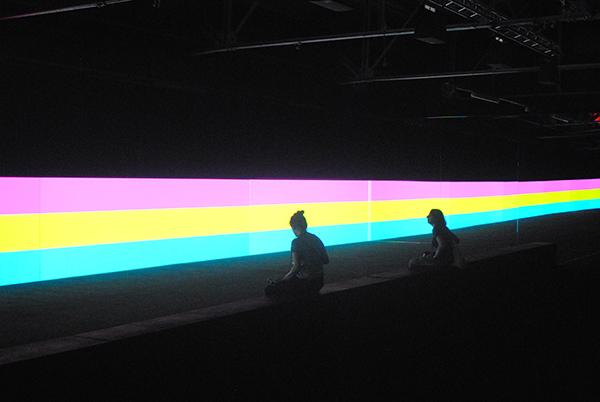It’s a sultry Soho afternoon, its Pride weekend, and the streets are beginning to hum. The day before my visit, the US Supreme Court ruled that same sex marriage is to be a nationwide right in America. In these circumstances its basically impossible not to like a rainbow coloured light display. Were it not for this association, Carsten Nicolai’s unicolor (2014), currently installed alongside another work, bausatz noto (1998) in Brewer Street Car Park, might make less of an impact.
Not because it isn’t visually impressive; the screen is bounded left and right by mirrors which creates the impression of limitless extension, ‘like a universe’ according to the accompanying text. Installed in a dark, low-ceilinged space, the glowing banner of light possesses the hypnotic quality often produced by large-scale light installations.
The work examines the psychology of colour perception and is the product of extensive research, with scientists Herman von Helmholtz, Werner Heisenberg and Wilhelm Ostwald cited as well as Bauhaus mavericks Johannes Itten and Josef Albers. Operating with a total of 16 ‘modules’ each examining a particular colour perception, the perpetually changing display is produced by RGB colour filters moving in high velocity. In practice, this means that variegated colours, in prismatic form, are initially clustered at the left hand side of the screen, and then integrate to fill the full field.
The work’s scientific underpinning is hard to access, terms and theorists are name-checked in the accompanying text but not explained, leaving the viewer in the dark as to the psychological discourse the piece is engaged in and the modes of perception it tests. The visitors that I shared the room with seemed little bothered by this, however, and in terms of pure affect the work’s luminous ebb and flow is a pleasure to behold.
The second piece, bausatz noto, offers visitors the opportunity to combine recorded sounds on four turntables. The bright, colour-coded records have been created so that each groove plays a different sound. Altering the RMP, frequency and so on further multiplies the possible sound permutations. This sideline to unicolour functions more as a space to play than a ‘serious’ art work and is all the better for it.
My interest in the science of colour sparked, I later look up Johann W. von Goethe’s Theory of Colours (1810), referred to in the exhibition’s accompanying literature as a fundamental entry point. Goethe’s approach, I learn, privileged perception over explanation. He wrote: “the highest is to understand that all fact is really theory. The blue of the sky reveals to us the basic law of colour. Search nothing beyond the phenomena, they themselves are the theory.” Nicolai’s show is truly in keeping with this dictum. Ignore the appeals to theory and enjoy the show.
Words: Laura Purseglove. Photo: P A Black © 2015
Carsten Nicolai: Unicolor – The Vinyl Factory Space – until 2 August 2015

